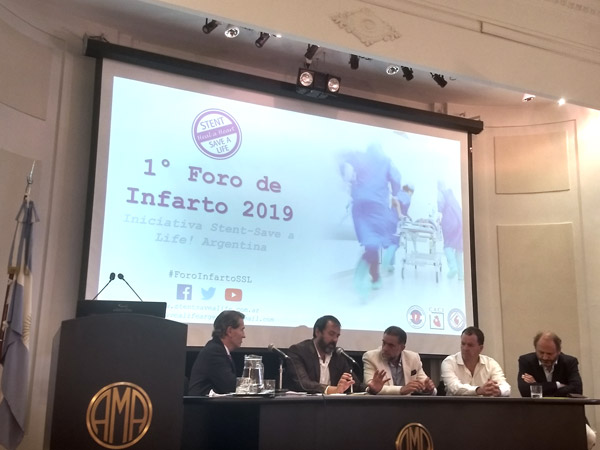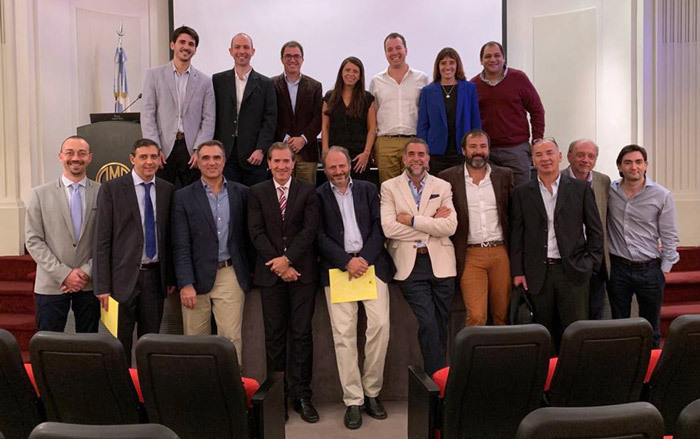In line with the global strategy, Stent-Save a Life! Argentina successfully held its 1st annual STEMI Forum
At the end of March, Stent-Save a Life! Argentina – member of the global initiative since 2014 – organised, in Buenos Aires, its first STEMI Forum that was also live streamed on YouTube to reach a broader audience.
Gathering the authorities of the scientific societies (Argentina Society of Cardiology, Argentine Federation of Cardiology and College of Interventional Cardiology), the Ministry of Health and representatives of the emergency medical services as well as of the public and private centres, the Forum was the first time all actors involved in the treatment of STEMI patients were brought together to address the reality of the AMI medical care in Argentina.
 Following the presentation of the country initiative’s progress, the primary objective was to discuss the strategies to improve the delivery of guideline complying therapy and patient access to the life-saving indication of reperfusion treatment. The current situation of STEMI treatment in Argentina, the reperfusion strategies available, the roles of the different actors and their integration to regionalise the treatment of STEMI patients were the main topics debated during the day along with many regionalisation examples across the country.
Following the presentation of the country initiative’s progress, the primary objective was to discuss the strategies to improve the delivery of guideline complying therapy and patient access to the life-saving indication of reperfusion treatment. The current situation of STEMI treatment in Argentina, the reperfusion strategies available, the roles of the different actors and their integration to regionalise the treatment of STEMI patients were the main topics debated during the day along with many regionalisation examples across the country.
With an estimated incidence of 50.000 STEMI per year, only about 35 percent of patients receive a reperfusion treatment – primary percutaneous coronary intervention (pPCI) or thrombolytics – with a low rate for the use of the pharmaco-invasive strategy.
Explaining this reality are:
- A highly fragmented healthcare system – resulting in a high number of EMS and centres, with and without pPCI capacity, working without any coordination. Although Argentina counts a sufficient number of pPCI centres, they are, unfortunately, mainly concentrated in urban areas, hence preventing a high percentage of the population to access them.
- And a lack of reperfusion culture – considered as an absence of commitment by the medical community to administrate reperfusion therapies in time to STEMI patients.
These 2 main barriers reinforce the idea that a regionalisation approach of the system is needed, setting-up STEMI networks, with the primary objective to re-perfuse as many patients as possible.
With the aforementioned barriers well identified, the “Door-to-Balloon” programme was initially launched as a continuous improvement process for pPCI centres based on the careful analysis of STEMI treatment delays. Each participating centre receives a monthly report with individualised suggestions to optimise prompt diagnosis and treatment of STEMI patients as well as a blind comparison with all the active centres, thus contributing to enhance the reperfusion culture.
46 pPCI centres from 11 Argentine provinces are currently participating in the programme with more than 5,000 patients treated since March 2016. Ignacio Cigalini – SSL Argentina Project Manager – presented an update of the results after 3 years of continuous work among which a significant reduction of the global door-to-balloon time from 70 (38-93) min to 50 (29-79) min.
“We are very glad about these results, not only because they reflect that it is possible for centres to organise themselves to improve the treatment of STEMI patients, but also because this programme has contributed to create a reperfusion culture in the medical community. Undoubtedly, this is the first step to start creating STEMI networks.”, Dr Alfonsina Candiello, SSL Argentina Country Champion, said.
Aiming at further developing the reperfusion culture, the next step is the implementation of the “Door-to-needle” programme in centres without PCI capabilities by focusing on educational resources for the administration of thrombolytics and the transfer of patients in a timely manner.
A crucial time during the Forum was the announcement by Dr Andrés Rosende – Coordinator of the Ministry of Health’s National Programme for the Prevention of Cardiovascular Disease – of the launch of the programme PASES designed to improve STEMI treatment in the public sector. An additional funding policy will be implemented for each STEMI patient treated and will be based on various quality criteria, including an early diagnosis, the application of reperfusion treatment strategies according to the characteristics of each treating centre – whether with thrombolytics or pPCI – or the timely referral to perform pPCI or a pharmaco-invasive strategy in the times recommended by the clinical guidelines.

“With this program, we seek to bring good clinical practices to public hospitals throughout the country and, in this way, achieve that more patients with STEMI be re-perfused in time.” said Dr Rosende.
Finally, some examples of regionalisation achieved in the country were presented- such as the STEMI network of public hospitals in Rosario and the one in the city of Buenos Aires – as well as some cases of coordinated work between private centres and ambulances illustrating the benefit to carry out a pre-hospital diagnosis and to pre-activate the centres with haemodynamic data.







